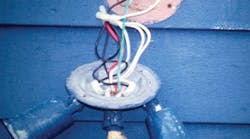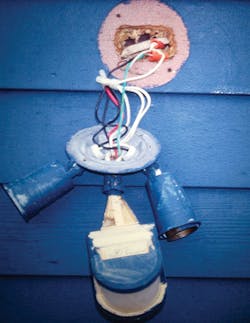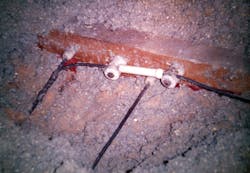Illustrated Code Catastrophes: Secs. 300.15, 410.23, 394.10, 394.12(5)
All references are based on the 2011 edition of the NEC.
A Real Can of Worms
I discovered this problem when I tried to replace this motion sensor and floodlight fixture at a customer’s house. A simple job turned into a big can of worms when I discovered every outdoor fixture was installed without a box. The paint outline and the hole cut into the clapboard appear to indicate there may have been a recessed box at some point. Perhaps the installer couldn’t figure out how to match a round cover with a rectangular box so he simply screwed the round cover directly to the clapboard and stuffed the wires and splices into the wall. Whatever the reason, it created some Code violations and increased the risk of fire.
Section 300.15 requires a box to be installed at outlet points and when splices are made in non-metallic sheathed cable. Because splices are a weak link in the circuit, a box is needed in part to enclose the splices and prevent any arcs and sparks caused by loose connections from igniting the surrounding combustible wood. This installation also violates the intent of 410.23, which similarly requires combustible surfaces exposed behind a luminaire canopy or pan to be covered with a noncombustible material.
A House-Sized Toaster
This situation is always scary to see. Concealed knob and tube wiring embedded in thermal insulation can become a real fire hazard. The thermal insulation traps the heat generated by the load on the conductor and causes the wiring to seriously overheat, acting like a giant toaster. This “toaster element effect” can ignite the combustible wood anywhere along the length of the wood that the knob and tube are mounted. The end result can be catastrophic.
You might be surprised to know that Sec. 394.10 does permit concealed knob and tube to still be installed in the hollow spaces of walls, ceilings, attics, and roofs for extensions of existing installations or elsewhere with written approval of the AHJ. However, 394.12(5) clearly prohibits concealed knob and tube from being used in those hollow spaces when such spaces are insulated with loose, blown-in, rolled-in, or foamed-in insulation that envelopes the wires. I want to emphasize the words “shall not be used” in that requirement. This means wherever concealed knob and tube wiring is present, it must be disconnected and discontinued from use whenever the walls, ceilings, floors, or attics get thermally insulated.






